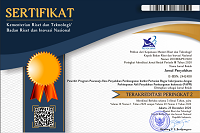Adoption of Fisheries Diversification Innovation in Poklahsar in Cigasong Sub-District, Majalengka District
Abstract
Cigasong District has fisheries potential like poklahsars. Poklahsar produces rebon shrimp brittle and carp. The development of fisheries potential can be done by diversifying processed fish. The research aims to study (1)changes in knowledge, attitudes, and skills of poklahsar after counseling on diversification of processed fisheries; (2) the process of adopting innovations; (3) the group that adopts the best innovation. Counseling was carried out using a demonstration method of diversification of processed fish. Respondents are members of poklahsar Sehati, Mitra Harapan and Pandawa Opat. Responses were observed using questionnaires, interviews, and observations; the data is displayed descriptively and simple tabulations are diagrams. The results showed; (1) an increase in knowledge, attitudes and skills in the whole poklahsar; (2) the process of adopting innovations in each group is different; (3) the results of the evaluation of the adoption of krispi eel innovation in poklahsar Sehati have the highest value of attitude change that is 10 and the value of knowledge 4, faster to implement than other poklahsar that is on the 5th week by two respondents from seven respondents, the 6th week the number of adopters increased into seven people and included in the early adopter category.
Downloads
References
Arsyad A. (2006). Media Pembelajaran. Raja Grafindo.
Ali, H., Tolinggi, W., & Saleh, Y. (2018). Persepsi Petani Terhadap Kinerja Penyuluh Pertanian Lapangan di Desa Talumelito Kecamatan Telaga Biru Kabupaten Gorontalo. Agrinesia, 2(2), 111–120.
Asnamawati, L. (2015). Strategi Percepatan Adopsi Dan Difusi Inovasi Dalam Pemanfaatan Mesin Tanam Padi Indojarwo Transplanter Di Kabupaten Bengkulu Utara Provinsi Bengkulu. Prosiding Seminar Nasional FMIPA-UT 2015: Optimalisasi Peran Sains Dan Teknologi Menuju Kemandirian Bangsa.
Baba, S., Isbandi, Mardikanto, T., & Waridin. (2011). Faktor-Faktor Yang Mempengaruhi Tingkat Partisipasi Peternak Sapi Perah Dalam Penyuluhan Di Kabupaten Enrekang. JITP, 1(3), 194–209.
BPS. (2018). Kecamatan Cigasong Dalam Angka 2018.
Dayana, & Sinurat, F. K. (2016). Komunikasi Penyuluhan Dan Adopsi Inovasi. Perspektif, 1(2), 111–123. https://doi.org/10.31289/perspektif.v1i2.87
Djaali, H., Muljono, P., & Sudarmanto, Y. (2008). Pengukuran dalam Bidang Pendidikan (Y. B. Sudarmanto (ed.)). Grasindo.
Firmansyah, A. S. (2015). Fungsi Komunikasi Penyuluh dalam Meningkatkan Hasil Panen Padi pada Petani Sawah Kecamatan Bungaraya Kabupaten Siak Sri Indrapura. JOM, 2(2), 1–15.
Hiola, N. A., & Indriana. (2018). Tingkat Adopsi Inovasi Sistem Tanam Jajar Legowo Pada Tanaman Padi di Desa Ilomangga Kecamatan Tabongo Kabupaten Gorontalo. Jurnal Agropolitan, 5(1), 53–68.
Mardikanto, T. (2014). Sistem Penyuluhan Pertanian. UNS Press.
Mulatmi, S. N. W., Guntoro, B., Widyobroto, B. P., Nurtini, S., & Pertiwiningrum, A. (2016). Strategi peningkatan adopsi inovasi pada peternakan sapi perah rakyat di daerah istimewa yogyakarta, jawa tengah, dan jawa timur. Buletin Peternakan, 40(3), 219–227.
Mustangin, Kusniawati, D., Islami, N. P., Setyaningrum, B., & Prasetyawati, E. (2017). Pemberdayaan Masyarakat Berbasis Potensi Lokal Melalui Program Desa Wisata Di Desa Bumiaji. Sosioglobal, 2(1), 59–72.
Nilamsari, R. M., Wibowo, B. A., & Dewi, D. A. N. (2016). Peningkatan Pendapatan Keluarga Nelayan Melalui Kelompok Usaha Bersama Wanita Nelayan Di Kelurahan Banten Kabupaten Serang. Journal of Fisheries Resources Utilization Management and Technology, 5(1), 87–93.
Noormansyah, Z., & Sendjaya, H. T. P. (2015). Hubungan Karakteristik dengan Respon Petani terhadap Program Pengembangan Kedelai. IJAS, 5(2), 55–60.
Nurdin. (2014). Pengaruh metode penyuluhan dan tingkat pendidikan terhadap pengetahuan berwawasan lingkungan. Jurnal Ilmu Pendidikan, 20(2), 201–206.
Putri, J. A. (2018). Identifikasi Potensi Wilayah Perikanan di Kecamatan Cigasong Kabupaten Majalengka Provinsi Jawa Barat. Sekolah Tinggi Perikanan.
Rogers, E. M. (1983). Diffusion of Innovations. The Free Press.
Rogers, E. M. (2011). Diffusion of Innovations. In Volker Hoffmann (Ed.), Modul: Knowledge and Innovation Management (4301-410) (Issue January, pp. 37–50). Hohenheim University. https://doi.org/10.1007/s10460-007-9072-2
Ruyadi, I., Winoto, Y., & Komariah, N. (2017). Media Penyuluhan dan Informasi dalam Menunjang Kegiatan Penyuluhan Pertanian. Jurnal Kajian Informasi Dan Perpustakaan, 5(1), 37–50.
Saimima, N. A. (2015). Diktat Pengolahan Modern. SUPM Waiheru Ambon.
Susilowati, T. (1987). Upaya Pembaruan Dalam Usaha Perikanan Di Indonesia. Oseana, XII(2), 42–51.
Warnaen, A., Cangara, H., & Bulkis, S. (2013). Faktor-Faktor Yang Menghambat Inovasi Pada Komunitas Petani Dan Nelayan Dalam Meningkatkan Kesejahteraan Masyarakat Di Kabupaten Takalar. Jurnal Komunikasi Karebo, 2(3), 241–250.
Widayanti, S. Y. M., & Hidayatulloh, A. N. (2015). Kinerja Kelompok Usaha Bersama (Kube) dalam Pengentasan Kemiskinan. Jurnal PKS Vol, 14(2), 163–180.
Wijayanti, A., Subejo, & Harsoyo. (2015). Respons Petani Terhadap Inovasi Budidaya Dan Pemanfaatan Sorgum di Kecamatan Srandakan Kabupaten Bantul. Agro Ekonomi, 26(2), 179–191.
Yuliana, E., & Farida, I. (2016). Pendekatan Partisipatif Dalam Pemecahan Permasalahan Aspek Produksi dan Pemasaran Abon Ikan (Kasus PadaKelompok Usaha Bersama Tenggiri Kabupaten Sukabumi). Jurnal Organisasi Dan Manajemen, 6(2), 132–145.
Yuliaty, C., Yulia, F., & Nasution, Z. (2011). Diseminasi dan Adopsi Inovasi Teknologi Pengolahan Hasil Perikanan ( Studi Kasus : Kegiatan Iptekmas BBRP2BKP di Yogyakarta ). Buletin Sosek Kelautan Dan Perikanan, 6(1), 18–22.
Yuniarti, T., Yudistira, A., Suhrawardhan, H., & Sumaryanto, H. (2011). Bakso Ikan Lele (Clarias sp.) Aneka Warna Sebagai Alternatif Jajanan Anak Sekolah. Prosiding Seminar Nasional Pengolahan Produk Dan Bioteknologi Kelautan Dan Perikanan Tanggal 6 Agustus 2011 Di Balai Pasca Panen Dan Bioteknologi Kelautan Dan Perikanan. Jakarta.
Authors who publish with this journal agree to the following terms:
- Authors retain copyright and grant the journal right of first publication with the work simultaneously licensed under a

This work is licensed under a Creative Commons Attribution 4.0 International License that allows others to share the work with an acknowledgement of the work's authorship and initial publication in this journal. - Authors are able to enter into separate, additional contractual arrangements for the non-exclusive distribution of the journal's published version of the work (e.g., post it to an institutional repository or publish it in a book), with an acknowledgement of its initial publication in this journal.
- Authors are permitted and encouraged to post their work online (e.g., in institutional repositories or on their website) prior to and during the submission process, as it can lead to productive exchanges, as well as earlier and greater citation of published work (See The Effect of Open Access).















